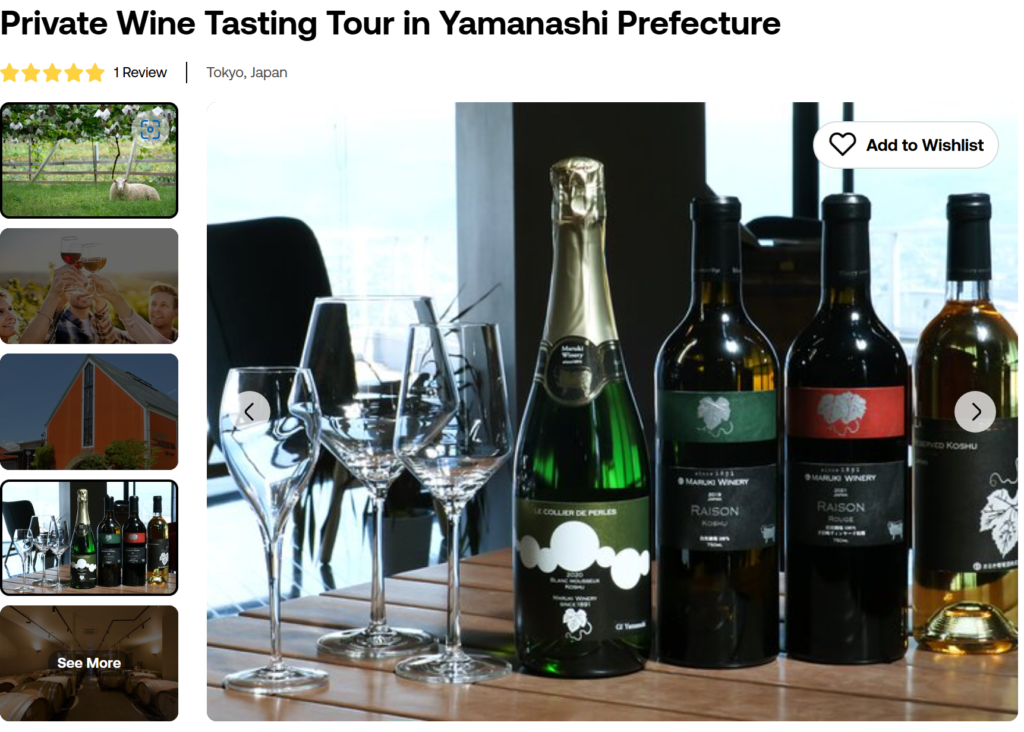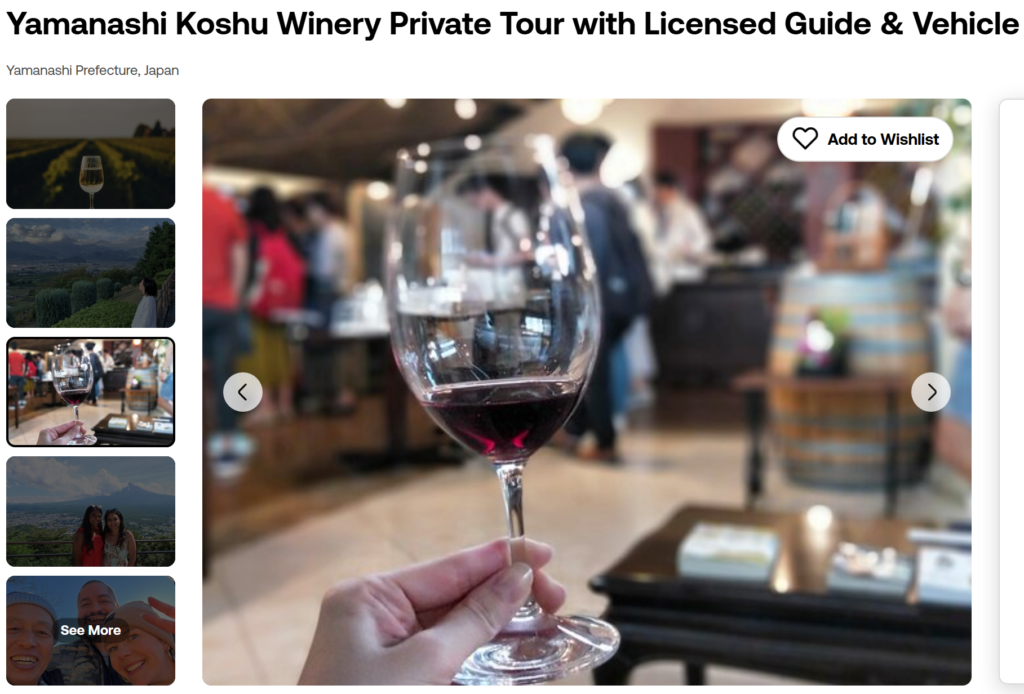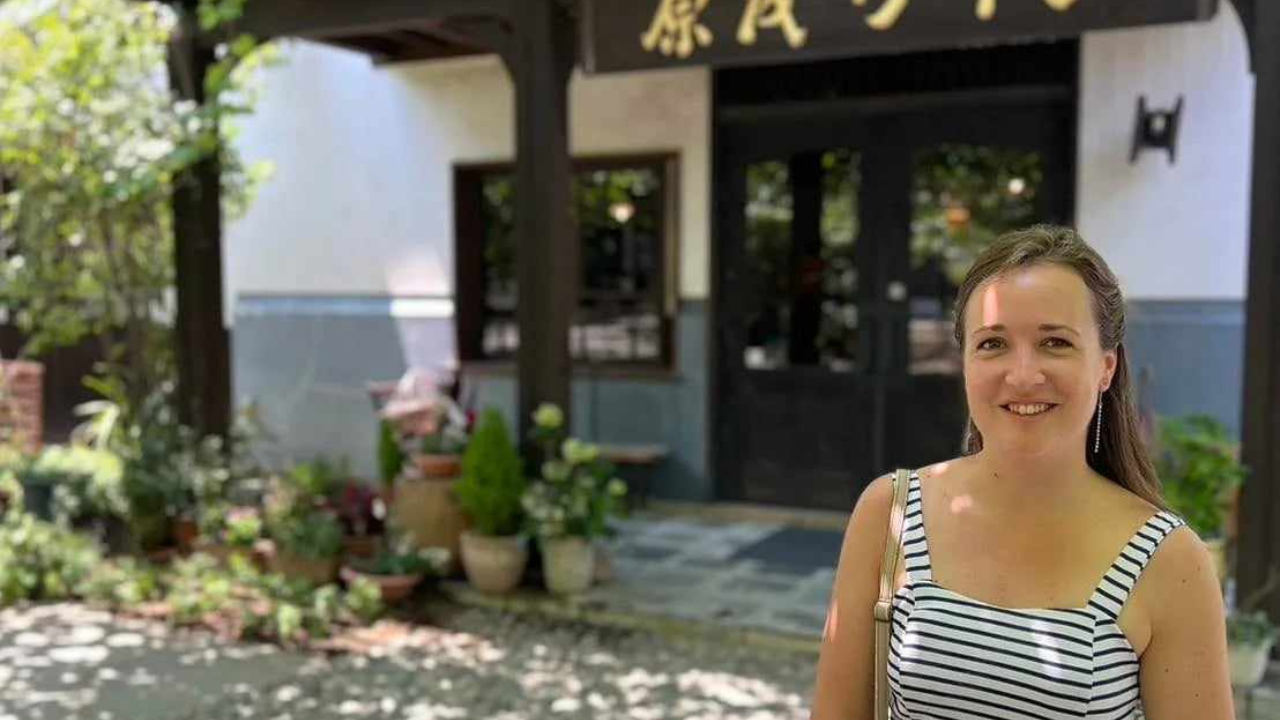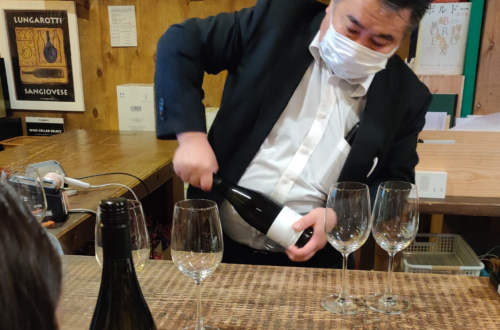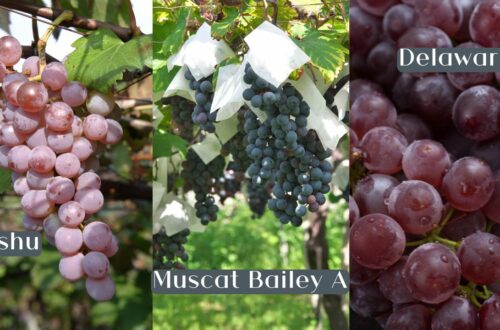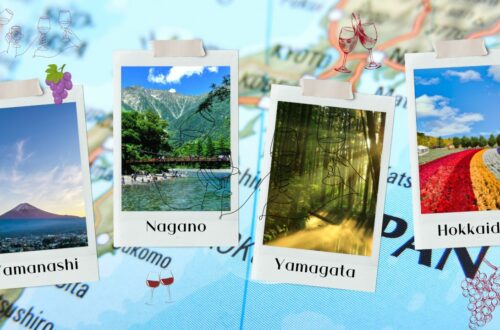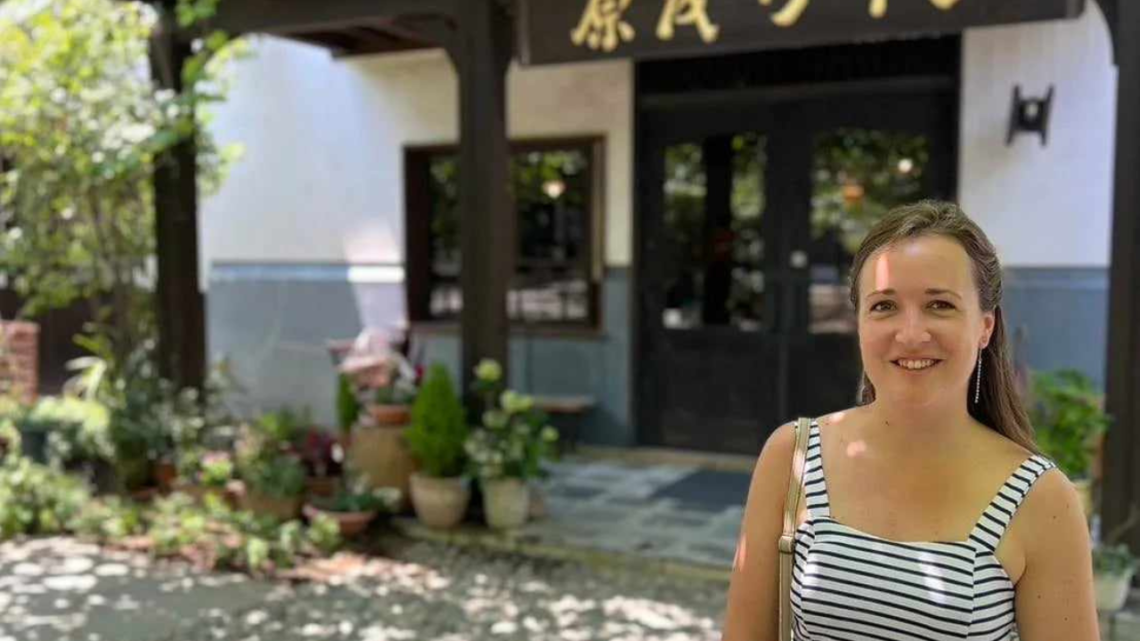
Explore Yamanashi: Japan’s Premier Wine Region
20 minutes read
Nestled less than two hours from Central Tokyo, Yamanashi wine region is Japan’s hidden gem for wine enthusiasts. It’s where it all started.
So when my sister suggested we went on a weekend trip there…I couldn’t say no!
It’s a beautiful place with lots of vines and mountains…and this is where you’ll find Japan’s most famous mountain : Mount Fuji!
So let me go into further details about this region (remember, Japan has four main wine regions) and I’ll share my discoveries too. I was able to visit 4 wineries and I want to talk to you about it, I learnt so much!
SUMMARY : Yamanashi wine region, nestled in Japan’s heart, is renowned for its stunning landscapes and wine production. Dominated by mountains like Mount Fuji and the Japanese Alps, this region’s unique terroir creates ideal conditions for grape growing. Yamanashi’s winemaking journey began with skepticism towards local varieties like Koshu, but innovators introduced techniques that transformed it into a high-quality wine. Today, Yamanashi is known for its three main grape varieties: Koshu, Muscat Bailey A, and Delaware. Koshu, with its fresh and citrusy notes, is perfect for Japanese cuisine. Muscat Bailey A offers a fruity, light red wine, while Delaware provides slightly sweet, aromatic whites. The region boasts a mix of traditional and European grape varieties, with ongoing improvements and international acclaim. Yamanashi’s wine industry includes 71 wineries, with notable ones like Kurambon Wine, Soryu Budoshu, and Lumière Winery, each offering unique and award-winning wines. The region is divided into three key areas: Katsunuma, Fuefuki, and Nirasaki-Hokuto, each with its own character and specialties. For a memorable experience, consider visiting Yamanashi. You can tour wineries, enjoy tastings, and explore the local culture. If you’re planning a trip or have questions, feel free to reach out!
Geography and location of Yamanashi wine region
Basically, Yamanashi is surrounded by mountains. This plain inside is called the Kofu Basin
South, there’s the famous Mount Fuji. West, we have the Japanese Southern Alps. North, there’s the Yatsugatake Mountains and the Chichibu Mountains.
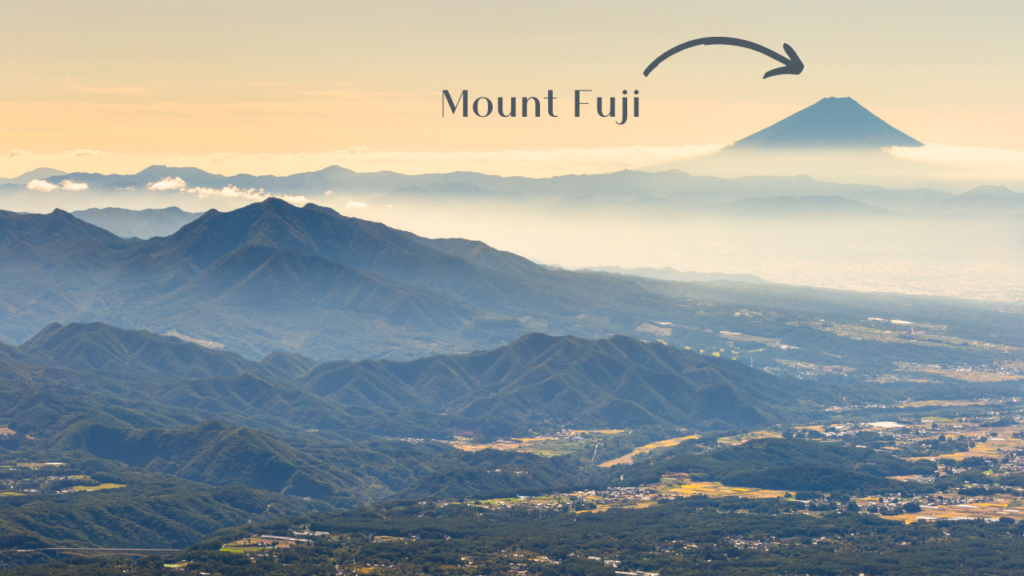
The capital city of Yamanashi is Kofu, which is less than two hours per train from Tokyo.
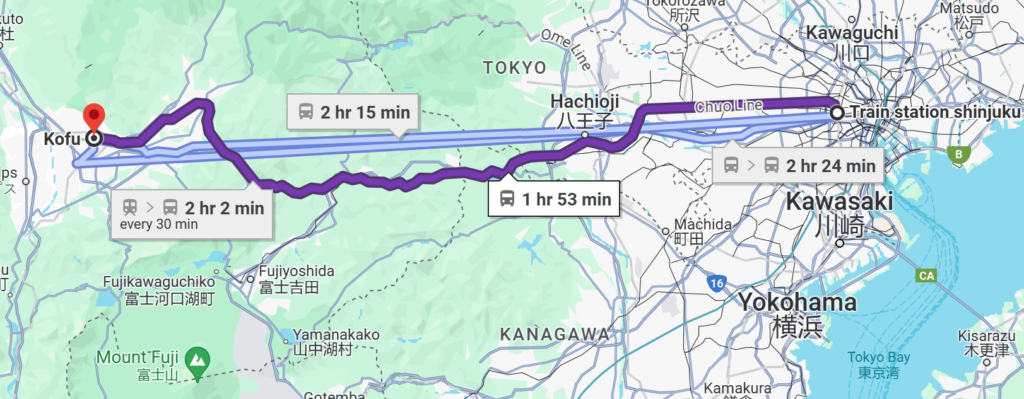
It lies just beside Katsunuma, which is the primary wine-producing area.
The Terroir of the Kofu Basin
All these tall mountains protect the grapes from bad weather.
What does this mean for the wine? This configuration creates a microclimate with lower rainfall and longer hours of sunshine, essential conditions for grape vines, and especially Koshu, which is the main grape variety there.
Concerning the soil, the Kofu Basin is mainly composed of sedimentary rocks and gravels from granite and andesite. These soils are well-draining and unsuitable for rice but perfect for fruit trees, including grapevines.
These soils come from the many small rivers that flow down from the surrounding high mountains towards the two main rivers – the Kamanashi and Fuefuki forming alluvial fans.
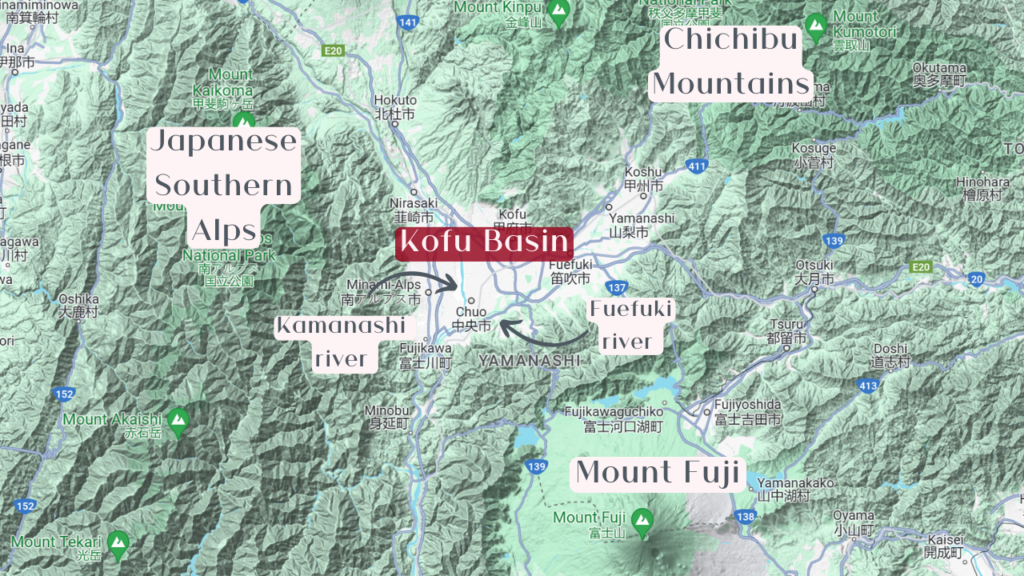
The evolution of winemaking in Yamanashi : Yamanashi wine history
Yamanashi’s winemakers have had quite the journey with winemaking…
NOTA : New to Japan’s wine history? Check out this post, wine in Japan actually goes back to over a 1000 years
For years, many winemakers in Yamanashi believed that traditional Japanese grapes like Koshu couldn’t produce good wine. (good thing they didn’t give up, right?)
So, foreign wines dominated the wine scene.
This began to change around 1975 when a few visionaries started to see the potential in Koshu.
How did they do it? Innovators introduced techniques like must clarification and low-temperature fermentation, turning Koshu into a fresh, fruity wine with a hint of sweetness.
NOTA : Must Clarification cleans the grape juice by removing solids before it ferments, leading to a cleaner wine. Low-Temperature Fermentation is a slower, cooler fermentation process that helps preserve the wine’s delicate flavors and aromas.
As tastes evolved, winemakers took on the challenge of creating a dry Koshu wine, sometimes with help from French experts.
They employed methods like sur lie aging to bring out citrus flavors and add complexity, resulting in a high-quality dry white Koshu that’s uniquely Japanese.
ANECDOTE : Do you know what is “sur-lie” aging? When the yeast die, it falls to the bottom of the bottle. We call it a “lie” then (lees). So “sur-lie” aging, means letting the wine age on its lees.
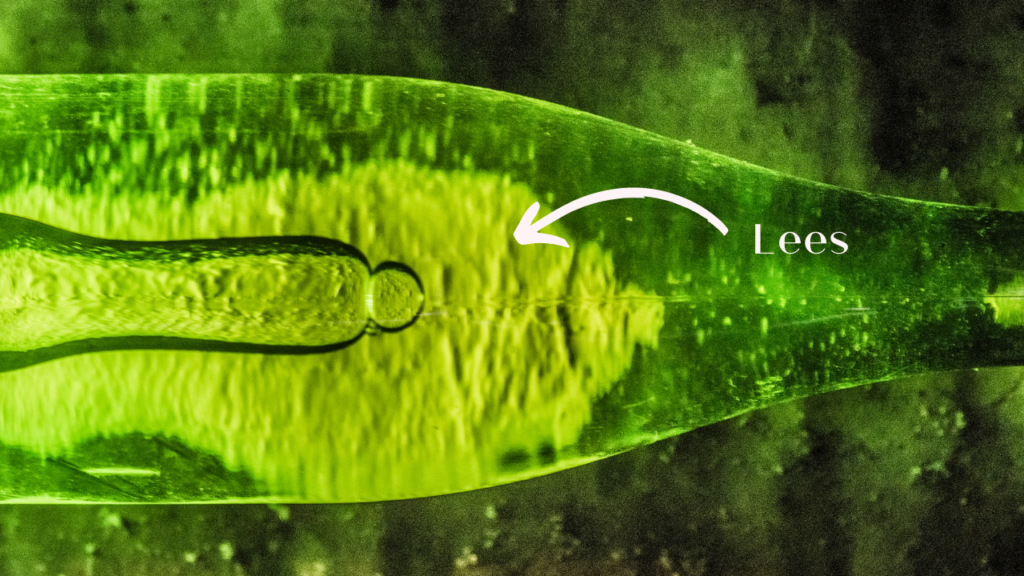
ANECDOTE: I recently posted a glass of Japanese wine and someone commented it couldn’t be real Japanese wine because it was written in French on the bottle. I’ve posted the photo underneath so you can see in a minute. But, what you must remember is that France and Japan have a really tight relationship when it comes to wine. Don’t forget, France gifted Japan with its best Burgundy crus.
So as you can read, Yamanashi’s wine production has faced its share of challenges.
Traditionally, most Koshu and other local grapes were grown by farmers for the table, not the bottle. Post-World War II laws prevented wineries from owning farmland, so they had to rely on these farmers.
Unfortunately, this often meant getting unsold table grapes, which aren’t ideal for winemaking. Plus, many farmers didn’t understand the different cultivation methods needed for wine grapes.
Over time, though, farmers and winemakers decided to collaborate which led to better quality in wines..
Actually, it was even more thant “just quality”, this teamwork has led to a new winemaking philosophy in Yamanashi: the belief that great wine is a product of its land.
So, even if it’s tough and costly, winemakers and consumers alike understand that a dedicated vine cultivation is essential for original and excellent wines.
Popular grape varieties in Yamanashi
Yamanashi is all about its traditional grape varieties, producing the most Japan Wine in the country. Koshu, Muscat Bailey A, and Delaware grapes are the stars here.
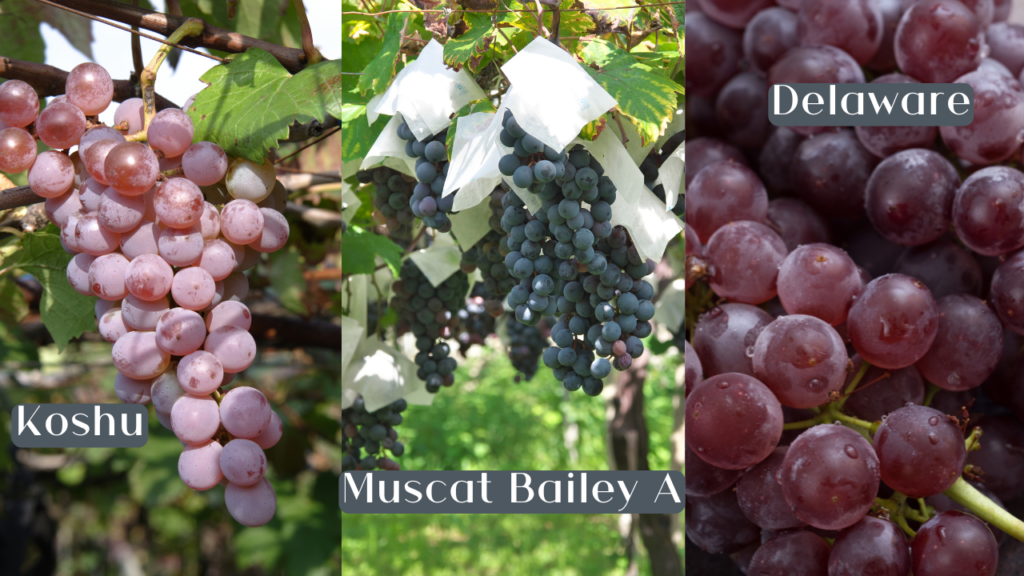
Koshu dominates Yamanashi’s wine scene, making up 52% of the region’s production. Muscat Bailey A follows with 23.6%, and Delaware comes in at 7.8%. Together, these three local varieties shape 83.6% of Yamanashi’s wine output.
Koshu is a white grape indigenous to Japan, known for its delicate, citrusy, and slightly floral character. To make a quick comparison with European varietie, it reminds me of Albariño or Vermentino (same grape variety as Rolle in Provence), which also offer a light and refreshing profile.
However, Koshu’s minerality and subtlety make it particularly suited to Japanese cuisine, where it complements the flavors without overpowering them. Indeed, Albariño and Vermentino (or Rolle) are usually grown in hot climates (Spain or Mediterranean/Corsica), so you’ll get less freshness than Koshu.
For me, Koshu is an excellent choice for summer drinking. Its crisp acidity and light body make it perfect for warm-weather sipping, especially when paired with seafood, sushi, or light salads. Consider it as an alternative to a chilled Sauvignon Blanc or a light Pinot Grigio.
Zenbei Kawakami created Muscat Bailey A in 1927 by crossing Muscat of Hamburg with the American grape Bailey. This grape thrives in Japan’s unique climate, but its wines didn’t always impress. Over time, winemakers took action, refining their techniques with careful land selection, late harvesting, yield control, and barrel aging. Their efforts paid off, and today, both local and international experts are starting to recognize the quality of Muscat Bailey A wines.
Muscat Bailey A could be compared to Gamay, particularly in its light body, bright fruitiness, and low tannin profile. Both grapes produce wines that are easy-drinking, approachable, and often enjoyed young. And they both have a fruit-forward nature, with flavors of strawberries, cherries. However, Muscat Bailey A can sometimes have a slightly sweeter edge and a more pronounced floral aroma, distinguishing it from the typically dry Gamay.
In my opinion, Muscat Bailey A wines are really great for the summers. The wines are super light with no tannins, and a lot of fruits. I definitely replaced my rosé with these kind of red wines. Its fruity, fresh profile is ideal for picnics, barbecues, or even as a chilled red for summer evenings. Muscat Bailey A works well with a range of foods, from grilled meats to slightly spicy dishes.
Delaware is a white grape that tends to produce slightly sweet, aromatic wines. It can be compared to Muscat or Riesling, but with a distinctly Japanese twist—often more restrained in sweetness and with a different balance of acidity.
Delaware wines are perfect for those who enjoy a hint of sweetness without going fully into dessert wine territory. These wines are great for sipping on their own or pairing with mildly sweet or savory dishes, such as cheese platters, fruit-based desserts, or even Asian cuisine like sweet-and-sour dishes. They can be a fun alternative to off-dry Rieslings or Moscatos.
Basically, Yamanashi doesn’t just stand out as Japan’s largest wine-producing region; it also prides itself on championing local grapes, setting itself apart from areas like Nagano’s Chikumagawa Valley, where European varieties dominate. Although Yamanashi produces only a small amount of European grapes—about 5% of its total wine output—grapes like Merlot, Cabernet Sauvignon, and Chardonnay face challenges in Japan’s humid climate.
Since the late 1950s, companies like Suntory, Mercian, and Manns have taken the lead in cultivating these European varieties. They shared their knowledge with smaller wineries, and their collaboration led to the creation of award-winning wines that earned international acclaim. Wines like Mercian’s Kikyogahara Merlot, Suntory’s Tomi Red, and Manns’ Solaris Shinshu Chardonnay are prime examples.
Today, Yamanashi’s vineyards commonly grow Merlot and Chardonnay, while Cabernet Sauvignon and Pinot Noir are limited to select fields due to their need for specialized care. Winemakers are actively seeking better-suited varieties, ideal sites, and improved cultivation methods, particularly for red wines. Recent achievements, such as the success of Cuvée Misawa made from 100% Cabernet Franc and the growing popularity of Syrah and Petit Verdot, demonstrate promising progress.
Yamanashi’s winemaking journey centers on terroir. The land, in a sense, chooses the grape, much like the wand chooses the wizard in Harry Potter (yes, I’m a big fan!). Winemakers in Yamanashi understand this connection deeply, which is why they focus on traditional Japanese grapes like Koshu and Muscat Bailey A.
Yet, they haven’t given up on European varieties. As winemakers and farmers continue to collaborate and refine their techniques, Yamanashi’s wines are poised to gain even more recognition and appreciation, both in Japan and worldwide.
I’m excited to see how this story unfolds in the coming years!
Classification of wine in Yamanashi
GI Yamanashi is the regional wine brand in Japan.
GI stands for Geographical Indiciation of alcoholic beverage labeling system and officially designated by Commissioner of National Tax Agency. It shows the labeled alcoholic beverage is produced within the production are and fulfills certain production standards.
The designation of GI requires that the characters of a liquoir product or agriculture product unique to a specific production area (quality, recognition in society etc) have been established
GI Yamanashi is the first wine geographical indication in Japan designated in July, 2013.
The wine can only indicate “GI Yamanashi” if they fulfill the criteria below :
- Produced by grapes harvested in Yamanashi Prefecture only
- The grape varieties are limited to 42 kinds including Koshu, Muscat Bailey A
- Produced by only the grapes containing more than certain levels of sugars
- Being brewed, stored, and bottled in Yamanashi Prefecture
- The alcohol content is not less than 8,5% in the case of brut wines, and not less than 4,5% in the case of sweet wines
- The chaptalization and the acidification are limited to meet criterion
- The GI Yamanashi Management committee strictly conducts the quality control test by sensory evaluation and others, and labeling evaluation
- To indicate GI Yamanashi, the wine requires to pass these inspections
Subregions in Yamanashi
Now, that you know more about Yamanashi wines, let’s delve deeper.
It’s like my math teacher always said : get the big picture and then circle in.
Yamanashi Prefecture hasn’t officially divided itself into winemaking regions yet, but for simplicity, we often talk about three key areas: Katsunuma, Fuefuki, and Nirasaki-Hokuto.
Katsunuma Region
Katsunuma is where Japan’s love affair with wine began.
This region is located on a gentle slope towards the center of the Kofu Basin, and has well-drained soils which makes it perfect for growing grapes. Some vineyards here climb up to about 600 meters on steep mountain slopes.
Look out for names like “Toriibira,” “Hishiyama,” and “Jyonohira”. These spots that are especially prized.
With 38 wineries, including both medium and large operations, Katsunuma is truly the heart of Japanese winemaking.
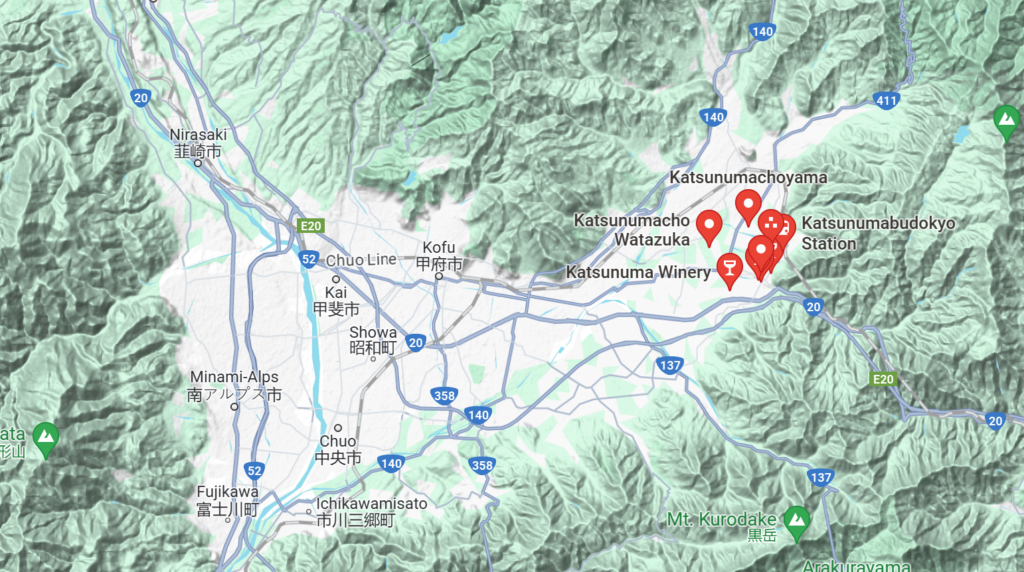
Fuefuki Region
Just west of Katsunuma, the Fuefuki region is flatter and known for its gravel-rich soils, thanks to the Fuefuki River.
Fuefuki is also famous for its peaches, with around 300,000 peach trees in the area.
There are 30 wineries there.
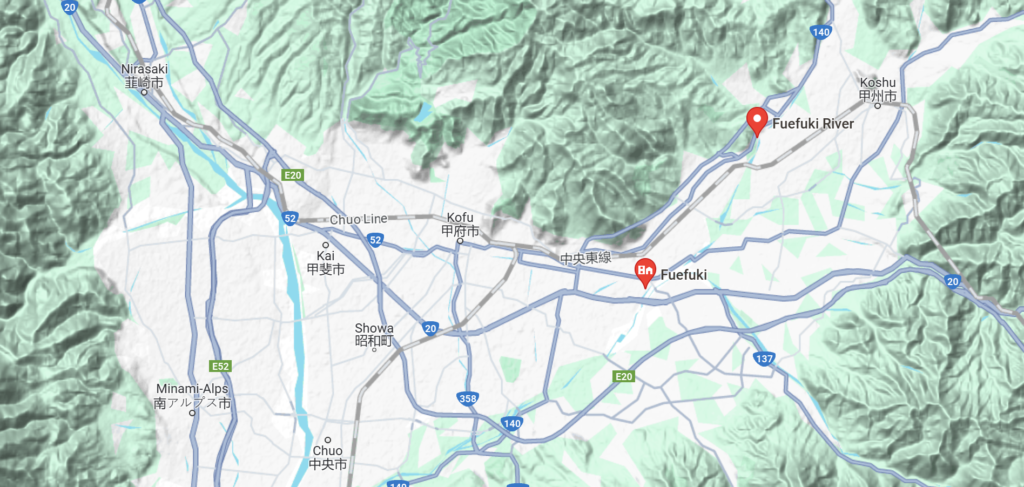
Nirasaki-Hokuto Region
Once a bit of an underdog, the Nirasaki-Hokuto region is now making a name for itself in winemaking.
This area benefits from cooler temperatures due to its higher elevation, long sunshine hours, and well-drained soils on south-east facing slopes.
The recent climate changes has made grape cultivation speed up grape cultivation .
Actually, many wineries from Katsunuma and beyond are either setting up their own vineyards in Nirasaki-Hokuto or sourcing grapes from the region to create exceptional wines.
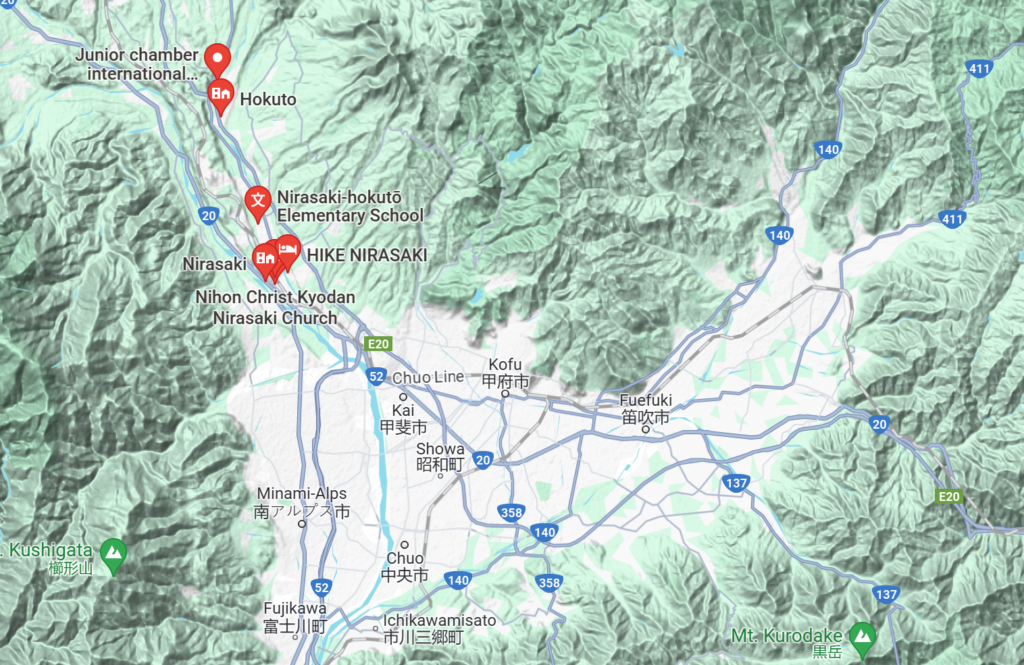
Top wineries to visit in Yamanashi
Across Yamanashi, you’ll find a total of 71 wineries, which is about 30% of all the wineries in Japan.
The five major wine producers all have their regional bases here, particularly in Katsunuma. While they do make wine from Yamanashi grapes, they also source the best fruit from other regions across Japan to craft top-quality Japanese wines.
Presenting all of the wineries in Yamanashi would make that a very long post, but send me an email or leave a comment if plan on visiting Yamanashi and I’ll give you some further tips on wineries.
NOTA : How can you send me an email? Just sign up to the newsletter and you can contact me anytime!
Examples of wineries in the Katsunuma region
Kurambon Wine was established in 1913 and reorganized in 1962. The winery changed its name from “Yamanashi Wine” to “Kurambon Wine” after the GI “Yamanashi” designation in 2013.
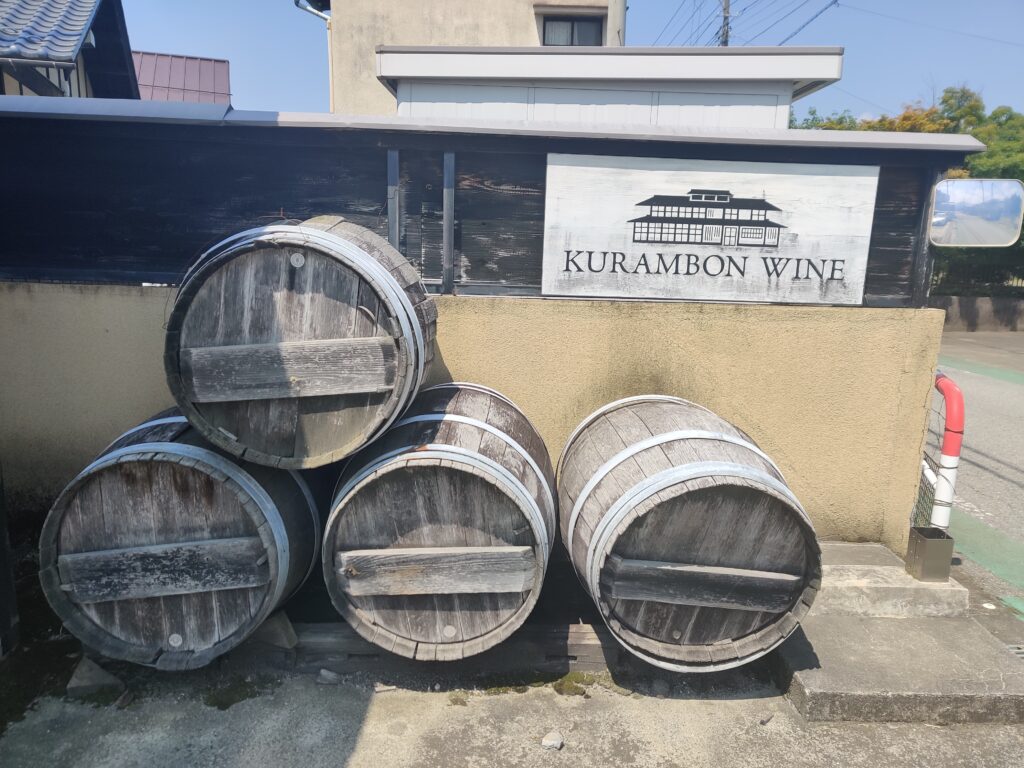
The winery’s main house was built 140 years ago for raising silkworms. It has now been turned into a Japanese-style room with tatami, which really gives you a sense of old Japanese architecture.
Mr. Takahiko Nozawa, the fourth-generation vigneron, shifted its focus to producing dry wines. He studied at an oenology college in Beaune, France, and was inspired by the food culture in the South of France to create wines that pair well with Japanese cuisine.
What is his philosophy? Well, Mr. Nozawa focuses on extracting the original flavor of grapes. For this he uses techniques such as harvesting grapes at the appropriate stage and using careful racking to preserve the wine’s taste. He introduced the concept of “natural vine growing” in 2007, based on nature farming, organic agriculture, and biodynamics, to fully express the terroir.
In the vineyard, he keeps the land grass-covered without tillage or fertilizers and using wild yeast for fermentation whenever possible.
The winery produces about 100,000 bottles annually, sourcing 60-70% of its grapes from farmers. But, Kurambon Wine has 2 hectares of its own vineyards, including “Shichihyoji” and “Toriibira,” two of the famous areas we talked about earlier.
Let’s take a look at their achievements (just to show that Japanese wines are getting more and more recognition) :
- The Cabernet Sauvignon from Shichihyoji won a gold medal at the Japan Wine Competition in 2007, a rare achievement for wines from European varieties in Japan.
- The Koshu wine has also been recognized with a silver medal at the International Wine Challenge in 2010.
Kurambon Wine exports its wines to high-end supermarkets in Britain, Japanese restaurants in France, and markets in Southeast Asia.
ANECDOTE : Visiting my first Japanese winery was an eye-opener, though not in the way I’d hoped. The tasting experience was quite different from what I’m used to—there wasn’t much interaction with the winemaker. Instead, you approach a machine, drop in a few yens, and select your wine, which felt more like a wine bar than a traditional tasting.
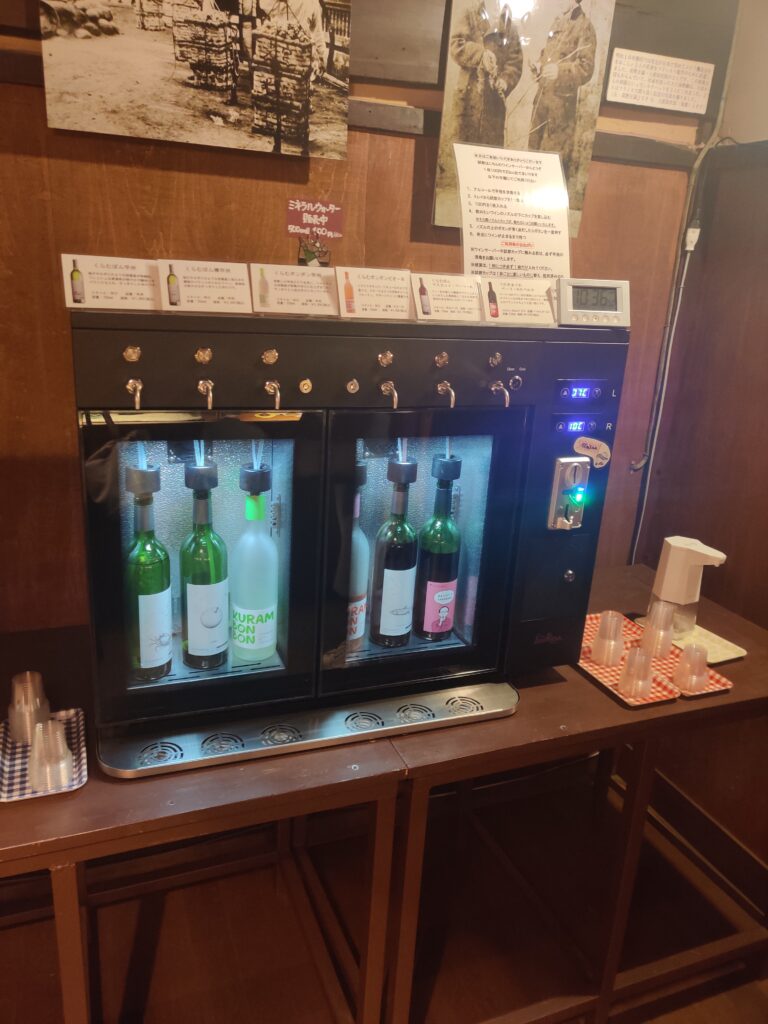
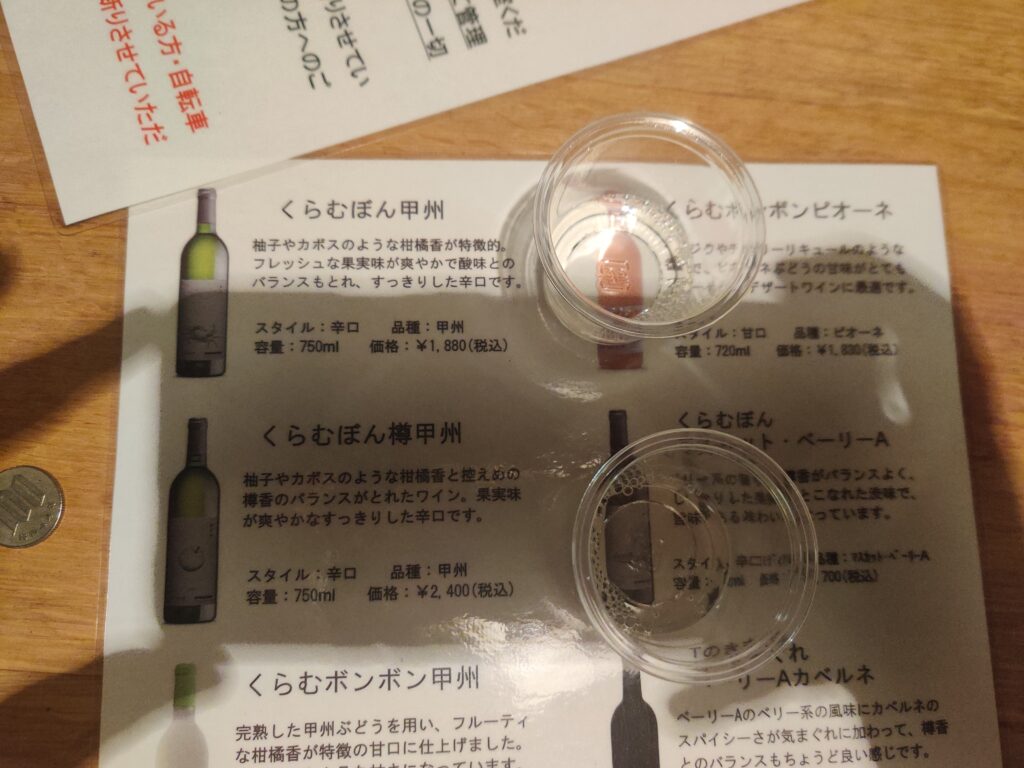
At Kurambon Winery, the wine was served in small plastic cups, making it difficult to fully appreciate the nuances of each pour. Despite this, I did enjoy the Koshu enough to buy a bottle and take it home. It turned out to be a great choice, reinforcing that maybe the best way to truly experience these wines is to buy the bottle and taste them on my own terms
Soryu Budoshu, founded in 1899 and reorganized in 2000, has expanded its vineyards along the Hikawa River Valley.
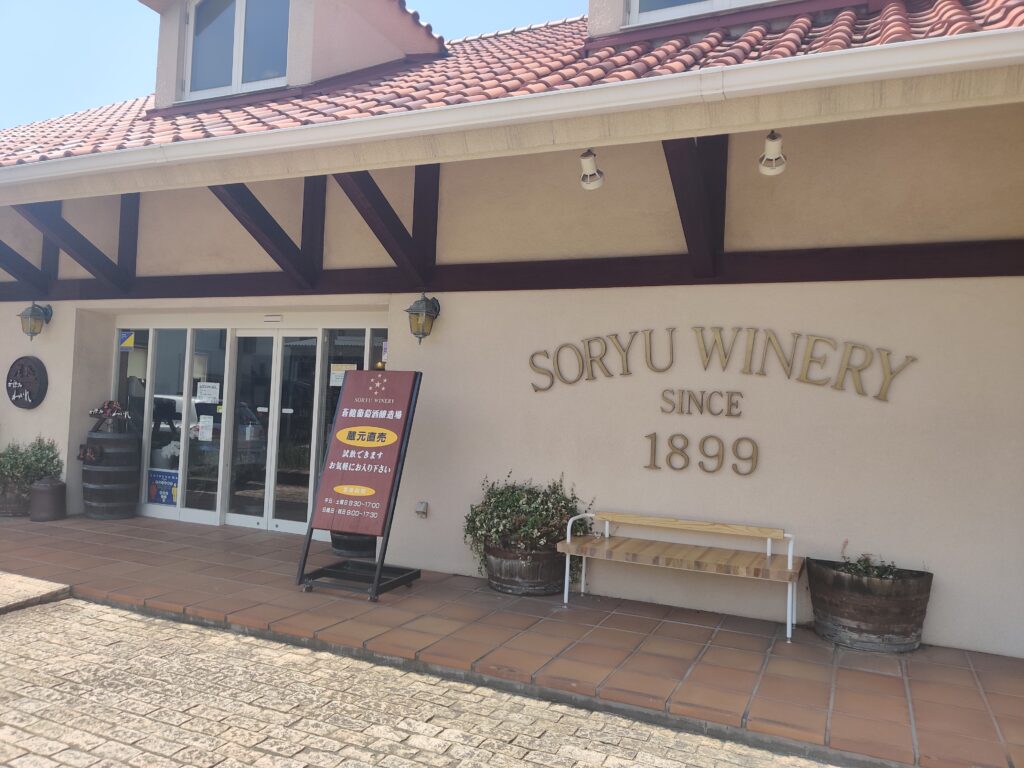
Mr. Hiromi Suzuki, the current president, studied winemaking sciences at Yamanashi University.
The winery focuses on making health-conscious wines made without additives. This approach has led to multiple awards, including gold medals at the Japan Wine Challenge and Japan Wine Competition.
Soryu Budoshu produces about 860,000 bottles of wine annually.
I brought home a bottle of their GI Yamanashi Merlot, which really stood out to me. It had a faint sweet taste like strawberry jam and raspberries.
Their Koshu wines also impressed me. It was a full-bodied wine with a complex taste, and a touch of minerals. It would go so well with oysters.
There are several other bottles I would have liked to try…but I was starting to run out of yens, such as their Citrus Scent Koshu. It is said to have flavours like citrus (hence the name!) and a clear and pleasant acidity.
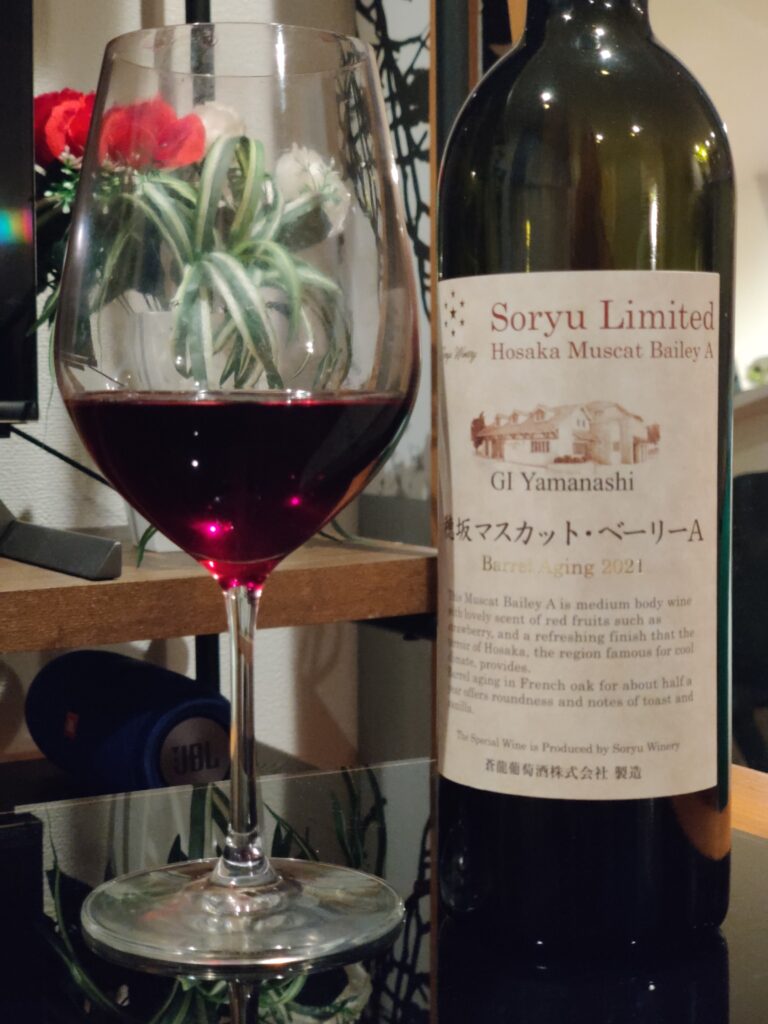
Haramo Wine was founded in 1924. You can easily recognise this winerie with its traditional wooden buildings. The main building was used to raise silkworms, the old earthen warehouse for wine storage.
The current vigneron, Mr. Shintaro Furuya, believes in making wines from locally grown grapes with minimal technology, respecting nature and consumer preferences.
Haramo Wine’s Koshu wines have been awarded gold medals at the Japan Wine Competition, including “Haramo Vintage Koshu sur Lie 2011.” The winery exports its wines to countries such as London and Taiwan.
Haramo Wine produces about 70,000 bottles annually, with 2 hectares of its own vineyards and 5 hectares of contracted land.
The Mercian Winery (Château Mercian) was first produced by the Nisshin Brewery Company Limited in Katsunuma in 1949. Later in 1961, the winery was acquired by Sanraku Liquor Company, which soon merged another winery formerly called “Daikoku Wine Company” a descendant of “Great Japan Yamanashi Wine Company” founded in 1877.
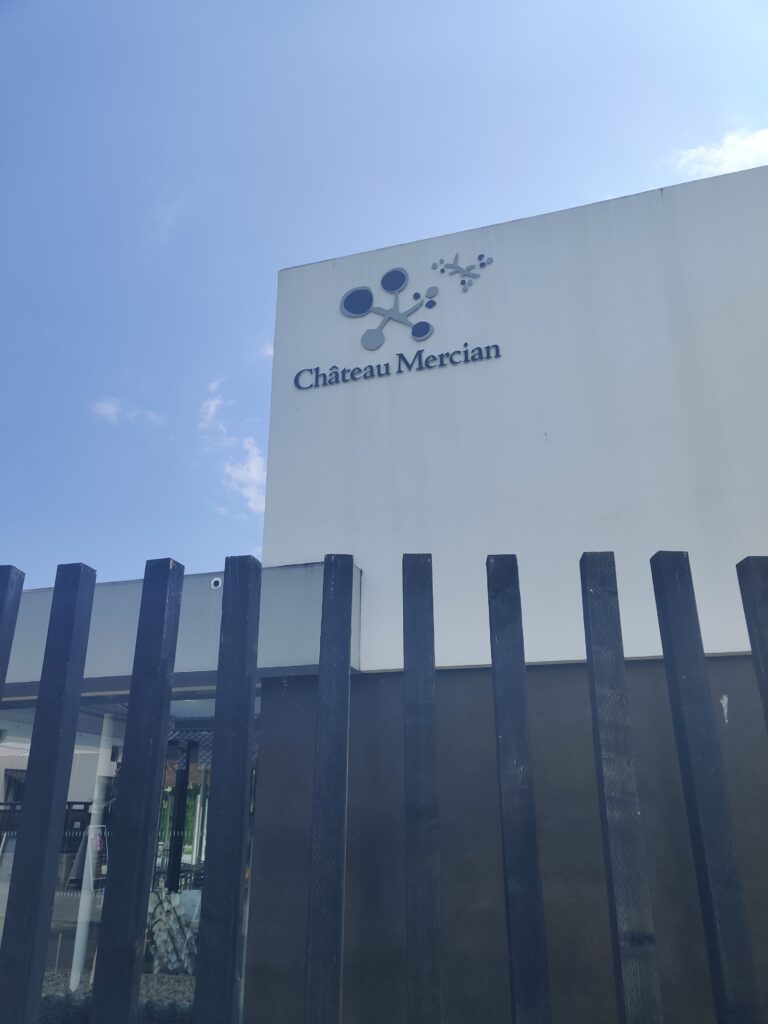
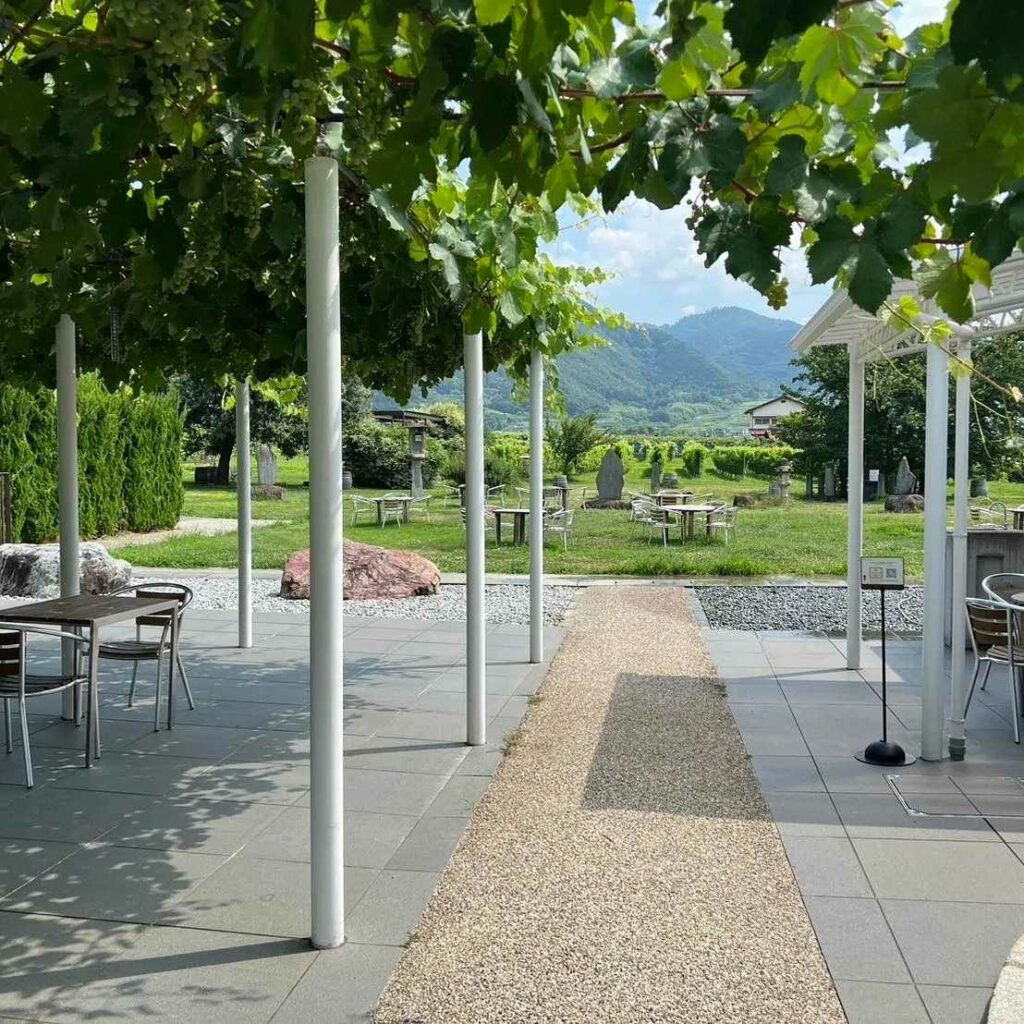
Mercian’s story is deeply intertwined with the roots of Japanese winemaking. The company traces its origins back to Japan’s first winery, eventually adopting the name “Mercian” in 1990. By 2007, it had joined the Kirin Group, solidifying its place as a key player in the wine industry.
In the late 1960s, as demand for wine surged, Mercian faced a critical challenge: a shortage of grapes. At the time, Japanese law prohibited companies like Mercian from owning agricultural land, including vineyards.
This restriction forced the company to rely on grapes sourced from independent farmers. As the grape shortage in Yamanashi became more pressing, Mercian expanded its reach, sourcing Merlot from Nagano’s Kikyogahara, Chardonnay from Chikumagawa Valley (Nagano) and Fukushima’s Aizu Niitsuru, and Riesling from Omori in Akita Prefecture.
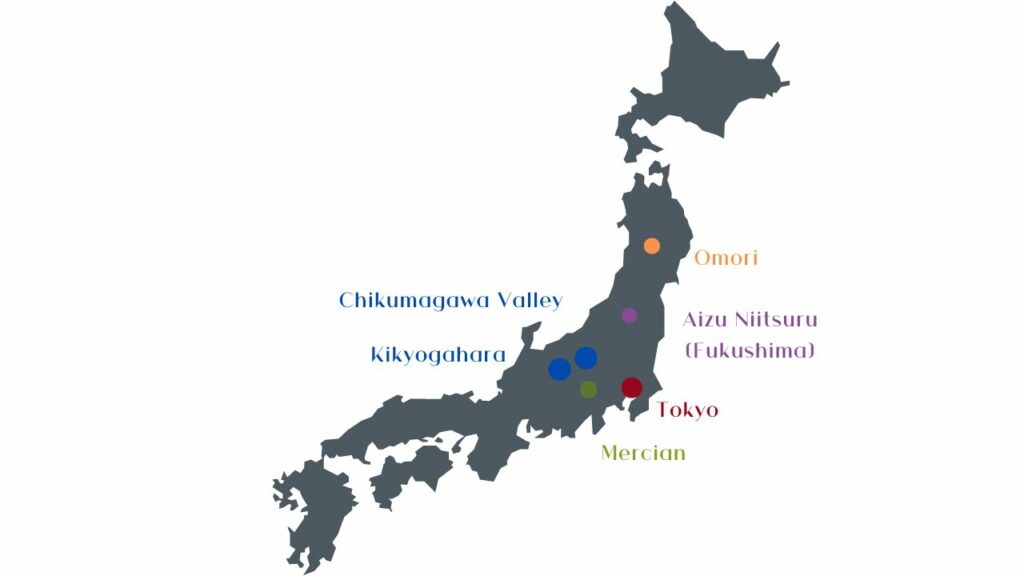
Maintaining strong relationships with these farmers became crucial. Mercian worked closely with them, offering guidance to ensure a steady supply of high-quality grapes. This collaboration laid the foundation for a tradition of trust and mutual support, a tradition that continued even during challenging times, such as when the demand for sweetened wine plummeted.
Out of these efforts, exceptional wines emerged. The Kikyogahara Merlot, in particular, marked a turning point in Japanese winemaking, proving that European grape varieties could thrive and produce world-class wines in Japan. This success, along with the acclaimed Hokushin Chardonnay, set a new standard for Japanese wines on the global stage.
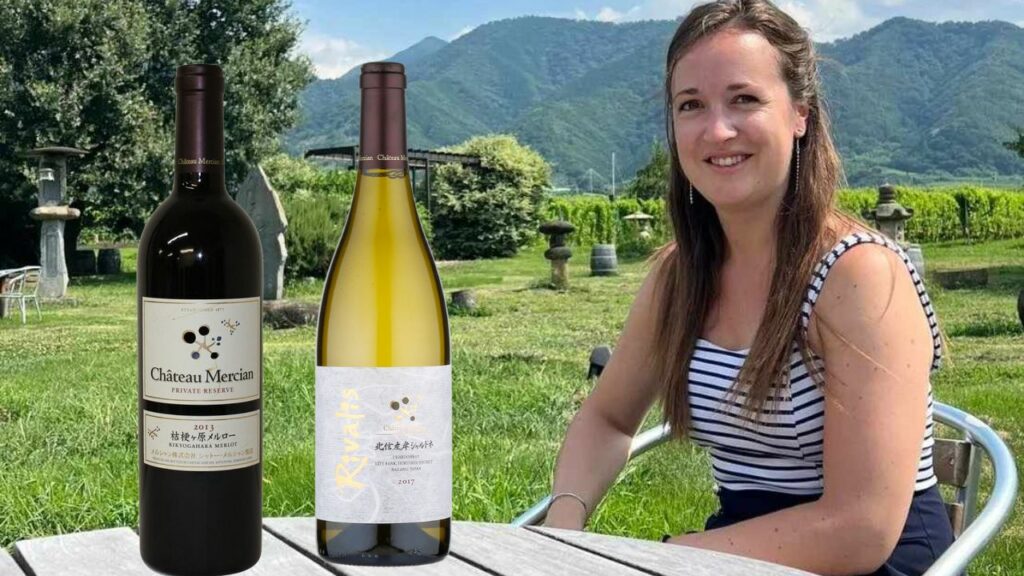
However, Cabernet Sauvignon proved to be a tougher challenge. Initial attempts to grow this variety through contracted farmers in Yamanashi failed.
Undeterred, Mercian took a bold step in 1984 by planting Cabernet Sauvignon in its own experimental vineyard in Jyonohira, Katsunuma. After years of meticulous care, the vineyard began producing outstanding Cabernet Sauvignon, culminating in the 1997 vintage winning a gold medal at an international wine competition in Slovenia in 2001.
This success didn’t come easily. It was the result of relentless dedication and advanced winemaking techniques. The Jyonohira Cabernet Sauvignon, with its complex berry flavors, balanced acidity, and long-lasting tannins, quickly earned a reputation as one of Japan’s top Cabernet Sauvignons, alongside Suntory’s Tomi Rouge and Manns Wines’ Higashi Yama Cabernet Sauvignon.
Mercian also played a leading role in elevating the quality of Koshu wine, sharing its innovations and techniques with other wineries in Yamanashi. The belief was clear: for Yamanashi to stand out in the market, wineries needed to work together, pooling their knowledge to elevate the region as a whole.
In recent years, Mercian has shifted its approach from relying solely on contracted farmers to developing its own vineyards. This change reflects a growing concern over the future supply of grapes, especially European varieties, due to the decline in the number of farmers.
To address this, Mercian opened the Mariko vineyard in Chikumagawa Valley in 2003 and planned to establish a new vineyard in Koshu city by 2017. There are also plans to expand in Kikyogahara and Mariko, taking advantage of relaxed regulations that now allow wineries to own and manage agricultural land.
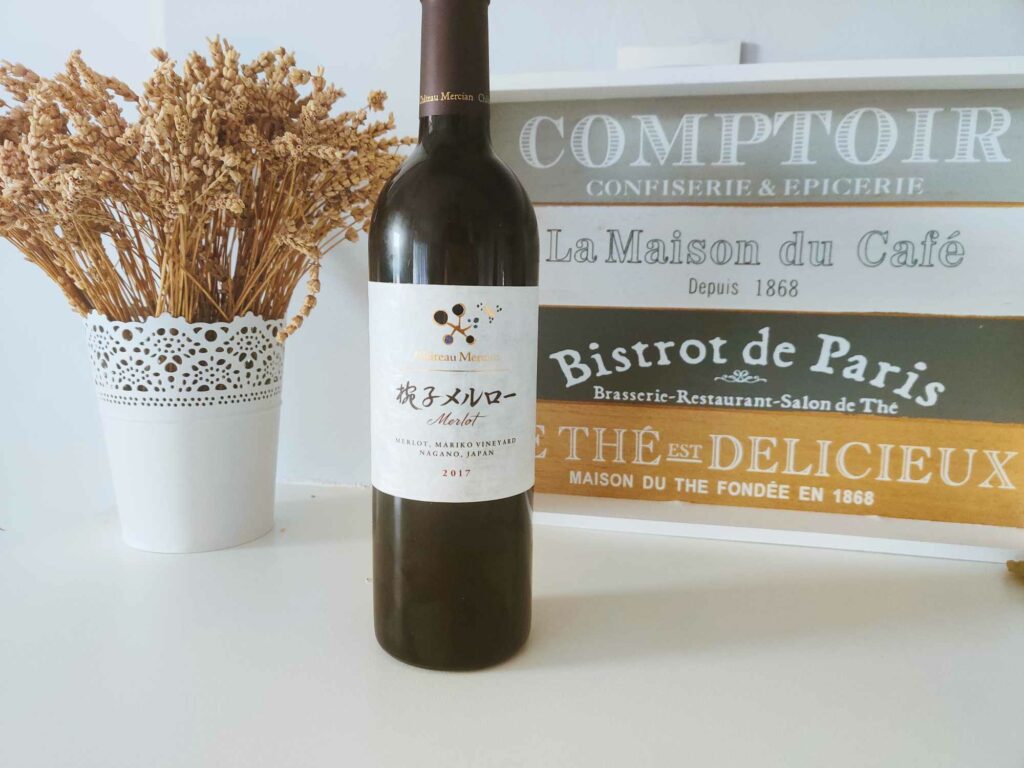
This shift represents a significant change in Mercian’s traditional approach, signaling a move towards producing its own grapes to ensure the highest quality, based on the principle that winemaking is fundamentally an agricultural endeavor.
At the helm of Château Mercian, Hironori Matsuo and vigneron Mitsuhiro Anzo lead the production of approximately 650,000 bottles of wine per year, with grapes sourced not just from Yamanashi, but from other regions as well. Their leadership continues to guide Mercian’s evolution, blending tradition with innovation as the company navigates the future of Japanese winemaking.
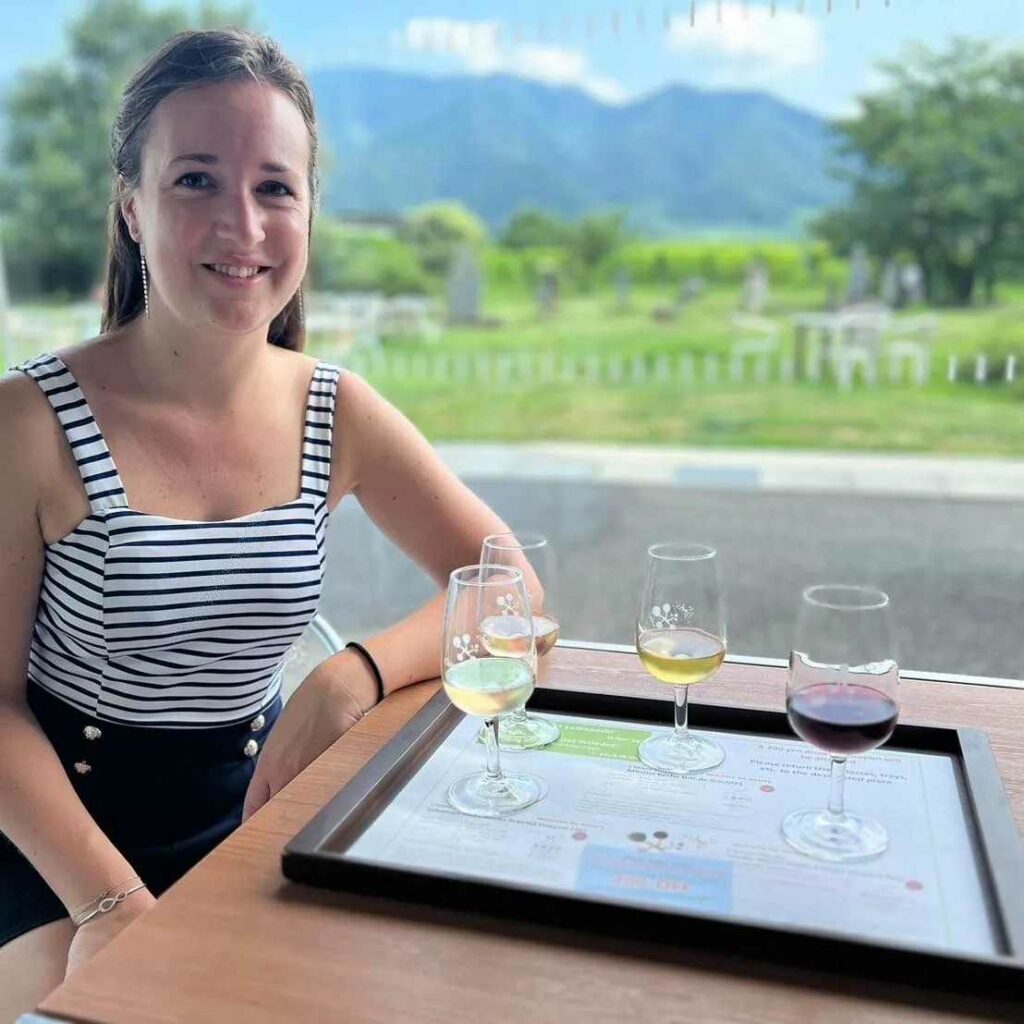
Each of the five major wine-producing companies in Japan has a winery in Yamanashi, with three of them located in the Katsunuma region. These three companies are Château Mercian, Grande Polaire and Manns Winery.
My tip to you : If you aren’t able to go to Yamanashi and still want to taste Grande Polaire wines, you can. They have a wine bar in Tokyo (and I think in Osaka too)
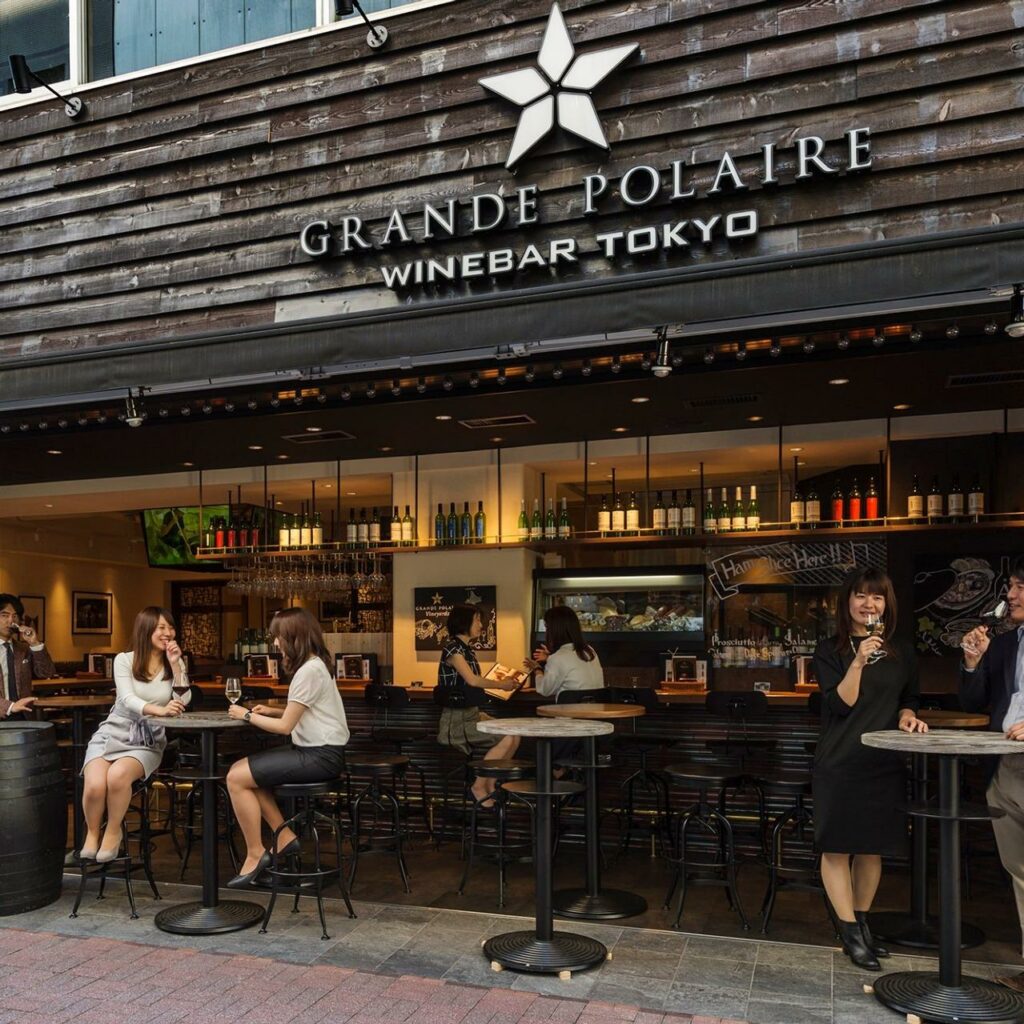
These companies, all part of the food and beverage industry, see the rising demand and unique quality of Japanese wine as a reason to establish these wineries. They produce wine using grapes from both Yamanashi and other quality grape-growing regions in Japan.
Other smaller wineries you may come across are (or that are on my list) : Diamond Winery, Grace Winery (or Chuo Budoshu), Katsunuma Jozo Winery, Marquis Winery, Marufuji Winery, Shirayuri Jozo… but I haven’t had the pleasure of visiting them yet.
Examples of wineries in the Fuefuki region
Lumière Winery, founded in 1885, stands out with a rich history that’s truly unique.
Back when authentic wine was hard to come by, Lumière was ahead of its time, making not just regular and sweetened wines, but also Port wine and whiskey. They didn’t just stop there—they made sure their wines reached both Yamanashi and Tokyo, even supplying the imperial family and the military. The founder’s family, being affluent landowners, likely played a key role in Lumière’s early growth.
By the 1960s, as wine started gaining popularity, Lumière quickly adapted, producing genuine wines faster than many others. Today, the fifth-generation vigneron, Mr. Shigeki Kida, continues to build on this legacy. His predecessor, Mr. Toshihiko Tsukamoto, expanded Lumière’s reach with a global outlook, leading to numerous international awards since the 1980s and forging partnerships in China.
Lumière is recognized as a prestigious château winery, respected both in Japan and internationally. For years, they’ve successfully produced European varieties like Cabernet Sauvignon and Cabernet Franc. More recently, they’ve turned their focus to enhancing wines from traditional Japanese grapes like Koshu, Muscat Bailey A, and Delaware. They’re also making significant progress in creating dry sparkling wines using these native varieties.
Their flagship wine, “Château Lumière,” is a testament to their craft. The “Château Lumière Rouge” is a blend of Cabernet Sauvignon and Merlot. It has rich flavours like matured blueberries and plums as well as spicy flavour. Well balanced wine with solid structure.
They have two Koshu wines. For the first one, Koshu was aged on lees, making a wine with fresh flavours such citrus and green apples. The second one was aged in barrel. It has more body with th same aromas.
Lumière’s vineyard, blessed with ample sunlight and well-drained soils, follows natural and biodynamic practices, steering clear of chemical pesticides and allowing the grass to grow freely.
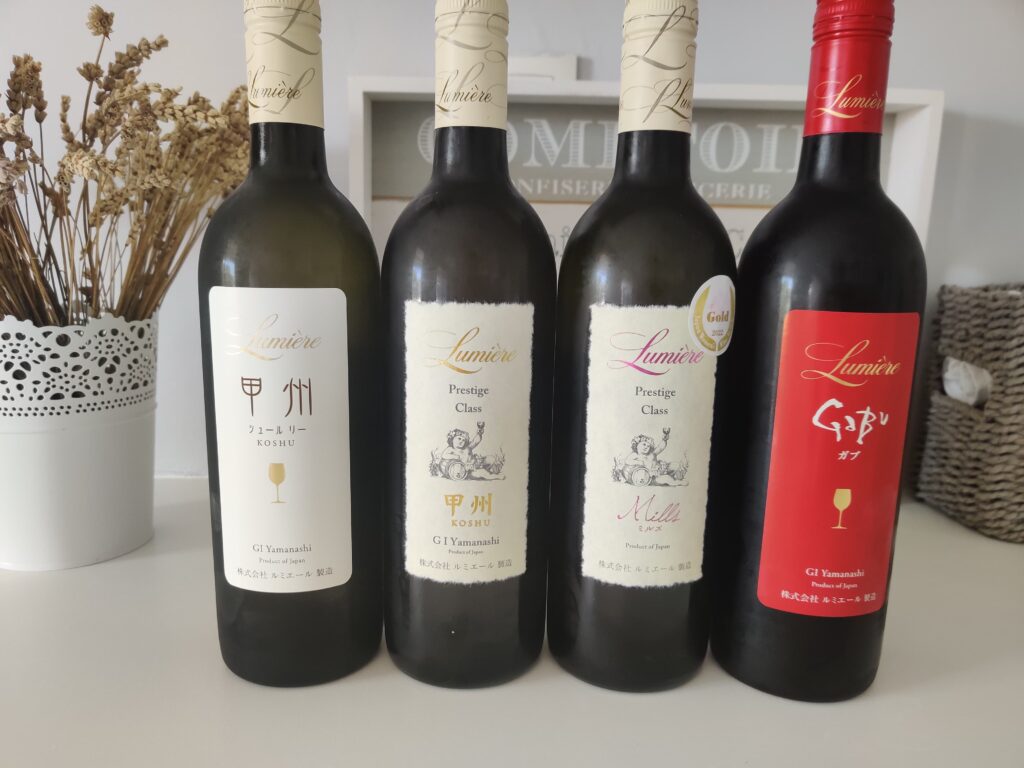
Located on a mountainside slope, Lumière Winery features historic granite fermentation tanks, registered as tangible cultural properties in Japan. Built in 1901, these tanks are still partly used today. The winery also includes a beautiful reception area, tasting room, historical exhibition room, and the exquisite restaurant “Zelkova.”
Producing about 300,000 bottles of wine annually, Lumière Winery is a testament to tradition and innovation, offering a unique and enriching experience for wine lovers.
Other wineries that are on my list are : Sadoya, Château Sakaori and Hombo Shuzo-Mars Yamanashi Winery.
Examples of wineries in the Nirasaki-Hokuto region
Unfortunately I didn’t have time to go to this region, but two wineries that would be on my list would be Misawa Vineyard and Suntory Tomi no oka.
Plan your wine tour in Yamanashi
Okay, you’ve learned a lot about Koshu grapes and Yamanashi wine! Now it’s time for the fun part: visiting!
I would suggest using a rental car in order to navigate through the wineries you want to visit (and a car does really come in useful if you buy some bottles).
But if you don’t want to drive or didn’t have time to do the paperwork to get your license translated, the good news is, you can also do it by train (1h40 from Shinjuku, Tokyo)!
I would suggest arriving in Kofu, which is at the heart of Yamanashi and the birthplace of wine in Japan. There you can visit Sadoya winerie and enjoy lunch and wine tastings at the local wine bars and restaurants.
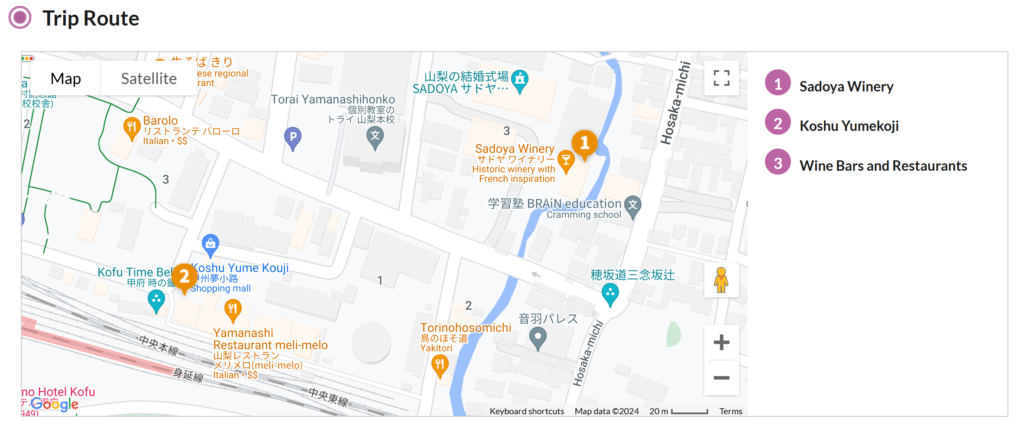
You can also book a taxi from there and go to other wineries. There’s a taxi that covers four representative wineries of the Yamanashi Prefecture Koshu Area : Shirayuri Winerie, Château Mercian, Lumière and Asaya Winerie. Since there are taxis every 15 minutes you can easily ride them, making it possible to visit more than just the four wineries.
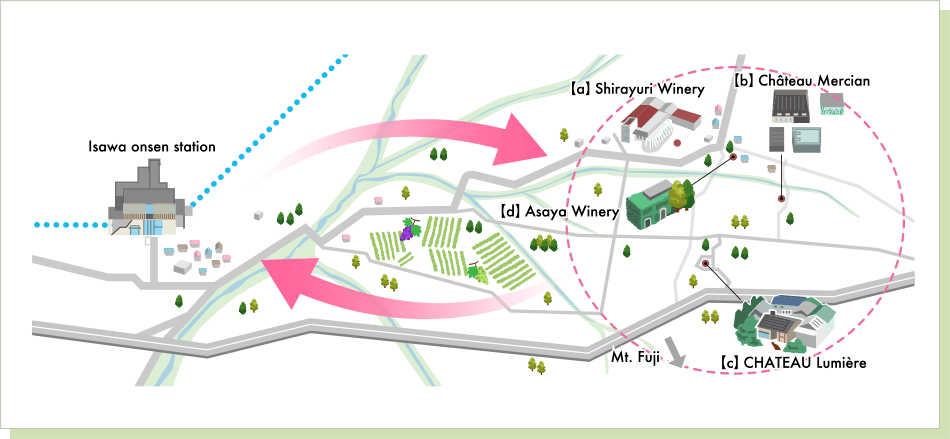
If you’re considering visiting the wineries, you have a couple of options: you can either book a wine tour directly from Tokyo (tour on the left) or from your hotel in Yamanashi (tour on the right)
To get the best experience, I highly recommend opting for a guided tour. English is rarely spoken at the wineries, and even if you speak Japanese, the staff available might not always have in-depth knowledge about the wines or the winery itself.
When I visited, I was fortunate to have my sister and her Japanese husband with me, but even then, the information provided was limited. A guided tour ensures you get the full story and enjoy your visit to the fullest.
Conclusion: Yamanashi Wines
So, when my sister suggested a weekend trip to Yamanashi, I couldn’t say no! It’s such a beautiful place with its lush vineyards and majestic mountains, and of course, Mount Fuji standing proudly in the distance.
I spent some time visiting a few wineries there, and I have to say, it was a fantastic experience. I learned so much about Yamanashi’s unique winemaking story. From the special terroir of the Kofu Basin to how winemakers have turned traditional Japanese grapes like Koshu into something truly special, it was all so fascinating.
Yamanashi really stands out as a top wine region, and there’s so much to discover. Whether you’re enjoying a crisp Koshu wine or exploring the rich history and innovation behind the scenes, there’s something here for every wine lover.
I’m excited to see where Yamanashi’s winemaking journey goes next!
If you’re inspired by Yamanashi’s winemaking story and want to dive deeper, why not plan a visit? Whether you’re a wine enthusiast or just curious to explore, there’s so much to discover in this beautiful region.
Feel free to drop me a comment or email if you have any questions or need tips on where to go and what to try.
Cheers to new adventures in wine!




